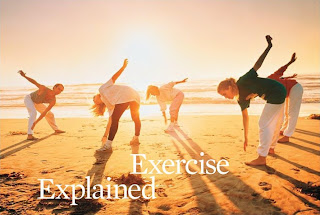What to know to get the most benefit
from working out
Whether you're a regular gym rat or taking your first baby steps on the treadmill,
managing both your exercise regimen and your blood glucose levels can be
tricky. Of course, you know that exercise is a great way to keep yourself
healthy but how do you know if you’re too high or low to work out? When is the
best time to work out? And why do you sometimes get those pesky high blood
glucose levels post-workout? Michael C. Riddell, PhD, is an exercise physiologist and
associate professor in the Muscle Health Research Center at the York University
School of Kinesiology and Health Science in Toronto. He has extensively
researched the role of exercise in managing type 1 and type 2 diabetes, and he
says the biggest hurdle in balancing exercise and blood glucose levels is
motivation. Exercise is as important, he says, as diet and medication, and
needs to be valued as such. In a study published in the March issue of the
journal Diabetologia, Riddell and his colleagues
found that with exercise, people with diabetes were able to control their blood
glucose levels and live healthier lives—even if they remained above
their desired A1C or weight-level goals.
What’s more, people with
all types of diabetes are encouraged
to do both aerobic (cardio) and weight-bearing (strength) exercise to become
the healthiest they can be. And both types of exercise are generally safe for
people with diabetes as long as they’re living free of complications of the
eyes, kidneys, and nerves. So put on some sneakers and get after it!
All Together Now
Time It Right. Your type of diabetes may indicate the best time of day to exercise. Riddell says people with type 1 may want to consider exercising when their insulin levels are a little bit lower—say, first thing in the morning, before taking insulin and eating breakfast. People with type 2 may especially benefit from physical activity after meals, which can tame blood glucose spikes. That said, getting physical activity regularly is more important than when you do it.
Test It Out. If you’re prone to lows, know your blood glucose trend before you bounce, boogie, or bowl. People using multiple daily insulin injections or a pump might start testing two hours before exercise, every 30 minutes or so, Riddell suggests. This gives you an idea of which direction your blood glucose is headed before you begin your workout. Then, to protect yourself from going too low or too high, test every 30 minutes during exercise. While that might feel frustrating, it will give you important data (see Understand Spikes, opposite).
Count the Minutes. Both the American Diabetes Association and the American College of Sports Medicine recommend that everyone get 150 minutes of aerobic exercise a week. Those activities are healthiest when they use large muscle groups, Riddell says— think walking, cross-country skiing, swimming, and rowing. Using big groups of muscles helps burn calories and lower blood glucose levels. Do some weight-bearing exercises three times a week to complete your physical activity. Weight-bearing activities involve putting a load on your bones, either your own body weight or external weights. “We know that having a healthy skeletal muscle mass is very important, but [aerobics] don’t build muscle,” Riddell says. “So we have to complement [aerobics with strength training]. We’ll live longer, more independently, and we’ll have much more energy throughout the day.”
Feels
Like the First Time
So maybe this is the first time you’ve ever gotten active. Or maybe it’s just been a long time since you followed an exercise routine. Deciding to make a change is the first step toward a healthier lifestyle. But don’t overwhelm yourself by trying to take on too much.
Set Goals. Any exercise is good, of course, but if you don’t have a map, you’ll never get anywhere. Setting small goals, Riddell says, can help you see results and feel accomplishment. Maybe you want to lower your fasting blood glucose or lose a couple of pounds within a month’s time. Those are very attainable goals, and once you reach one, you’ll be inspired to keep going.
Start Small. You don’t have to run a marathon, or even a 5K. “If you start slowly, by doing just 15 minutes of aerobic-type activity daily, or anything longer than 10 minutes, that’ll have some benefit,” Riddell says. Aerobic exercise is as simple as brisk walking, riding a bicycle, or jogging. If you can do 10 minutes of aerobic exercise three times a week, you’re already on your way. When you can do that, add a little more time each day, until you’re getting 30 minutes of aerobic exercise every day.
Mind Your Muscle. All exercise routines should include some strength training, in which you’re working and building your muscles with weight-bearing activity. You don’t need dulbbells or any special equipment the weight of your body counts. “People who are starting to exercise can get a lot of benefits by just doing the motion without any weights,” says Charlotte Hayes, MMSc, MS, RD, CDE, CES, author of The “I Hate to Exercise” Book for People With Diabetes. For example, you can sit in a chair and do a leg lift. “For people who are deconditioned, after 10 or 15 times, they’ll start to feel their muscles working,” she says. You can fill up water bottles and use them as weights, too. And don’t forget, you can do sit-ups or push-ups for free, in your home, with no equipment necessary. Hayes suggests doing them while watching TV in the evenings.
Stress Less. Diabetes management can take its toll, mentally. Riddell suggests yoga or tai chi to help manage stress while getting in some physical activity; these routines also improve flexibility and balance.
Take It To The Limit
Step It Up. So you've been walking the same 45 minutes loop in your neighborhood four times a week, for months now. It's time to kick it up a level, because just as you get bored with your regular routine, so do your muscles. "It is a good idea to mix it up because you become overall more fit when you challenge your body to do something new," Hayes says. Consider doing intervals: Hayes suggests walking very briskly for three minutes, then at your usual pace for a couple of minutes. Repeat for the length of your workout. You could also try incorporating an exercise class into your routine.
Find a Buddy. Having someone to cheer you along is a major motivator, especially if you’re getting the Same Ol’ Workout Blues. Support groups for people with diabetes can be a great way to get the motivation you need. Alexis Jacobs, 37, of Santa Monica, Calif., is a marathoner with type 1. To stay motivated and get exercise tips, she has made friends through the Diabetes Exercise and Sports Association. “Obviously, you learn from the doctor, but you learn more from collaborating with other people who have the same lifestyles,” she says. “For me, it’s inspiring. It’s motivation to stay in good control.”
Understand Spikes. Some people, particularly those with type 1 diabetes, might find that their blood glucose levels are higher after exercising and require some fine-tuning of insulin. Confusing! Those blood glucose spikes are called the exercise whip: When you vigorously exercise for just a few seconds or minutes, the adrenaline released during that activity can cause blood glucose levels to go up, and sometimes stay up for hours in recovery. “If you do exercise that combines both [short bursts of energy and longer, low- or mid-intensity exercise],” says Riddell, “that has been shown to have a moderating effect, which is really nice.”
Prepare for Lows. You can go low during and even hours after exercise, so have a plan ready. Test your blood glucose frequently. Eating a snack before exercise may help. Talk to your doctor about how best to manage your medications.








